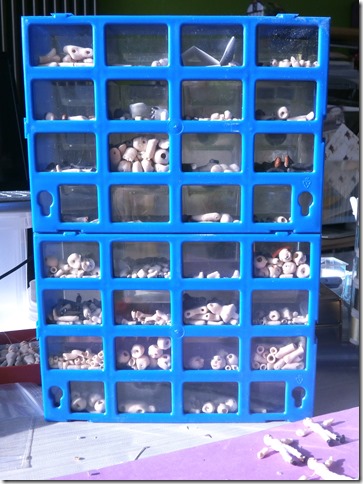Over the last few weeks I have poured, fired and assembled 44 dolls. To be exact I have assembled 44 dolls from the many more that I poured, fired, glazed, china painted and fired again.
When you are making dolls so small that a few millimetres out can cause rejection, you learn not to work when you are tired, which is why it takes so long. As to the wastage rate, here is a picture which may explain –
this is the back of the two drawer stack that holds all the reject bits. All the leg without a friend, all the hand without a hole, every head with a neck hole too big to stop the bead falling out, every wire loop that stuck through the arm, every wire hole that was too small to get the wire through and all the china paint that looked great going into the kiln and rubbish coming out.
The box stack is the result of many years, porcelain is so exacting it’s always worth keeping oddities in case they find a pair eventually. There are also many more heads (because you only need one head) and bodies (for the same reason) than there are arms and legs, or more commonly, upper arms, forearms, calves, thighs, feet and hands which all have to be paired.
I did at first think the cause of all the oddities was that I was not very good at making porcelain dolls. In truth, at first, I wasn’t. The first time I opened the kiln on my own dolls made from my own moulds made from my original sculptures, it was extremely obvious that I had a lot to learn. Later I was comforted by researching the history of various china companies. Manufacture in England using local clays began in the 1740s in various places, the locations of which have only been subsequently discovered when archaeological excavations revealed the presence of dumps of wasters – all the bits that had gone horribly wrong. A trip to any museum with a good collection of eighteenth century china may make you wonder how they could tell the wasters from the good stuff. Individuality abounds. Some figurative pieces are sufficiently hilarious to make the aspiring doll maker feel they have nothing to lose.
I used a very few really awful bits of practice porcelain, smashed up with a hammer for crocking pots. Smashed up china is a good drainage provider. I had to stop as soon as the pieces started resembling dolls, and I don’t think I ever chucked any on the garden. If anyone in the future is going to identify my house as a location for doll making, they’d not be able to do so by excavating wasters.
This locality has been a place for making things by hand for at least two thousand years. My garden was a neolithic flint factory, I turn up the flint nubs from which the hand axes and stone knives were struck all the time. I do know the flints I find are the discards but whether someone threw them away in disgust wondering if they’d ever be any good, or whether they are just leftovers, I cannot say.
Under my beech hedge grow the lords and ladies that Tudor laundresses used to starch lace collars and keep them high. Where the canal is now, were reed beds that thatchers have used for making roofs. A walk into town takes me up Smith Street where busy metal workers bashed out armour for the castle for hundreds of years.
It’s a hive of industry round here. Shakespeare was five miles away in that direction, scribbling furiously. His father was a glover, sewing very small seams by hand.
I feel I have landed in the right place and fit right in to all the history that is here, working away to write words and make things that I hope will make people happy.
At least I might do if I stopped gasbagging to you and got on with some making.
Four weeks to the show!
details as always at www.miniatura.co.uk
~~~~~~~~~~~~~

